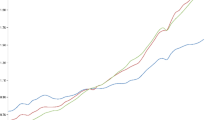Abstract
Hope is a crucial component of agency involving the setting of goals, visualization of obstacles, and increasing willpower in the effort of achieving a desired goal. This hope is not simply optimism and is potentially a bridge between structure and agency. Yet, the powers of hope in sociology have been greatly unexplored including the ability of collective hope to create social change. This lack of hope is particularly poignant in environmental sociology as the sub-discipline looks for solutions to some of the greatest challenges humanity and the planet faces. This article discusses the undercurrent of pessimism in environmental sociology and calls for the integration of hope as it is necessary for generating potential social environmental change.
Similar content being viewed by others
References
Best, J. (2001). Social progress and social problems: Towards a sociology of gloom. The Sociological Quarterly, 41(1), 1.
Braithwaite, V. (2004a). The hope process and social inclusion. The ANNALS of the American Academy of Political and Social Science, 592, 128.
Braithwaite, V. (2004b). Collective hope. The ANNALS of the American Academy of Political and Social Science, 592, 6.
Breyman, S. (1997). Social studies of science and activism: STS as campus greening movement. Philosophy and Social Action, 23(1), 5.
Clark, B., & York, R. (2005). Carbon metabolism: Global capitalism, climate change, and the biospheric rift. Theory and Society, 34, 391.
Courville, S., & Piper, N. (2004). Harnessing hope through NGO activism. The ANNALS of the American Academy of Political and Social Science, 592, 39.
Davidson, F. (2004). Understanding environmental governance. Organization and Environment, 17(4), 471.
Drahos, P. (2004). Trading in public hope. The ANNALS of the American Academy of Political and Social Science, 592, 18.
Foster, J. B. (2005). The treadmill of accumulation. Organization and Environment, 18(1), 7.
Freudenberg, W., Frickel, S., & Gramling, R. (1995). Beyond the nature/society divide: Learning to think about a mountain. Sociological Forum, 10(3), 361.
Greider, T., & Lorraine, G. (1994). Landscapes: The social construction of nature and the environment. Rural Sociology, 59(1), 1.
Gould, K., Pellow, D., & Schnaiberg, A. (2004). Interrogating the treadmill of production: Everything you wanted to know about the treadmill but were afraid to ask. Organization and Environment, 17(3), 296.
Johnson, B. (2005). Overcoming ‘doom and gloom’: Empowering students in courses on social problems, injustice, and inequality. Teaching Sociology, 33, 44.
Larsen, K., Groberg, D., & Simmons, D. (1993). Authoritarianism, perspectives on the environment, and work values among social science students in former socialist and western societies. Social Behavior and Personality, 21(3), 251.
Lawrence, G. (2005). Promoting sustainable development: The question of governance. Research in Rural Sociology and Development, 11, 145.
McAdam, D. (1999). Political process and the development of black insurgency 1930–1970. Chicago: The University of Chicago Press.
McGeer, V. (2004). The art of good hope. The ANNALS of the American Academy of Political and Social Science, 592, 100.
Milbrath, L. (1995). Psychological, cultural, and informational barriers to sustainability. The Journal of Social Issues, 51(4), 101.
Pepper, D. (2005). Utopianism and environmentalism. Environmental Politics, 14(1), 3.
Pettit, P. (2004). Hope and its place in mind. The ANNALS of the American Academy of Political and Social Science, 592, 152.
Scheinberg, A. (2003). The proof of the pudding: Urban recycling in north america as a process of ecological modernisation. Environmental Politics, 12(4), 49.
Sheppard, J. (2004). Reducing pessimism’s sway in the environmental ethics classroom. Worldviews, 8(2), 213.
Spaargaren, G., & Arthur P. (1992). Sociology, environment, and modernity: Ecological modernization as a theory of social-change. Society and Natural Resources, 5, 323.
Vlachou, A. (2004). Capitalism and ecological sustainability: The shaping of environmental policies. Review of International Political Economy, 11(5), 926.
Author information
Authors and Affiliations
Corresponding author
Rights and permissions
About this article
Cite this article
Lueck, M.A.M. Hope for a Cause as Cause for Hope: The Need for Hope in Environmental Sociology. Am Soc 38, 250–261 (2007). https://doi.org/10.1007/s12108-007-9017-7
Published:
Issue Date:
DOI: https://doi.org/10.1007/s12108-007-9017-7




